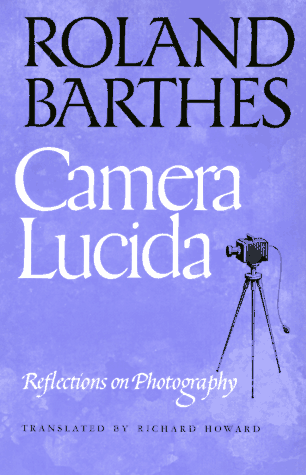Roland Barthes’ Camera
Lucida: Reflections on Photography trans. Richard Howard (New York: Farrar, Straus and Giroux, 1981). 
Roland Barthes was a French
literary theorist, semiotician, and major contributor to structuralist and
post-structuralist thought. His
most famous works include a collection of essays Mythologies (1957) in which he explores the intersection of
semiology and Marxist critique and his essay “The Death of the Author” (1968)
in which he considers the impossibility of identifying authorial intent because
of the many possibilities for interpretation in any text. In 1981, Barthes brought his attention
to the study of signs and language to the topic of photography with Camera Lucida.
A central component in Camera Lucida is Barthes’ consideration
of a picture of his mother taken when she was a child as she posed in a
garden. This “Winter Garden
Photograph” is the only image that Barthes discusses at length but does not
reproduce within his text. Writing
shortly after her death, Barthes recounts his desire to know and to recognize
his mother as he pours over the photographs left behind in her apartment. The image of his mother as a young
child leads Barthes to confront the connection between photography and
death. All photographs carry an
indexical relationship to their referents—Barthes notes that he “can never deny
that the thing has been there. There is a superimposition here: of
reality and of the past” (Camera Lucida, 76. Emphasis in original). Barthes labels this persistent presence
of the referent the essence of photography and the “That-has-been.” In other words, he cannot refute the
reality of his mother’s presence within that winter garden many years before he
knew her. Each picture, and for
Barthes especially this picture of his mother, also conveys its relationship to
time and hence to death. In a
point of connection to Sontag’s assertions that a photograph can record the
light that has emanated off a referent years and years before, Barthes notes
that the “That-has-been” is a frozen moment that will “touch [him] like the
delayed rays of a star” and so the photograph carries with it an element of
what we might call this-will-die (Camera
Lucida, 81). In other words,
Barthes can see in the “Winter Garden Photograph” both the reality of his
mother before he knew her and he can recognize that she will die.
Barthes also provides two
useful—and for him, interrelated—terms for approaching an analysis of any
photograph: the studium and the punctum. Barthes identifies the studium
as a kind of general interest in the image for what it tells the viewer about
the historical context in which the photograph was taken and in which the
photograph is viewed. Barthes
always grounds the experience of the studium
in the viewer (and always himself in these personal musings); he notes that
by way of the studium he can enjoy
the photograph as political testimony, historical document, or cultural
testament to the gestures, settings, figures, faces of an earlier time (Camera Lucida, 26). The punctum,
for Barthes, disturbs an appreciation of the studium. He describes
the punctum as an element of the
photograph that pricks, wounds, or stings him. This punctum can
be a tiny glint in the eye of a person caught unposed in the background of an
image or an uncovered foot of a corpse lying in the street of a war-torn
city. Just as with the studium, the punctum is grounded in the experience of the viewer. Recognition of the punctum is often an accidental and is always a highly subjective
response—in fact, the punctum for
Barthes in “The Winter Garden” photograph is his recognition of the
“This-has-been” and “This-will-die.”
It is through both punctum and
studium that Barthes identifies the
contextual and the personal within photographs.
Many of these essays are extremely
dense and unraveling them might make for a difficult task in any undergraduate
class aside from, perhaps, an upper division seminar dedicated to the study of
visual rhetoric or photography. Indeed,
Barthes can be so complex and occasionally so infuriating, that I might
consider excerpting a few of his more approachable passages—such as the studium and the punctum—discussing each with students, and then practicing
application of these two terms to several images. Working extensively through the nuances of Barthes’ argument
may, however, be helpful for instructors of visual rhetoric interested in the
semiotics of photography or the history of photography theory.
Works
cited and other works of interest
Barthes, Roland. Camera Lucida: Reflections on Photography.
New York: Hill and Wang, 1981. Trans. Richard Howard.
Orvell, Miles. American Photography. Oxford:
Oxford University Press, 2003.
Sontag, Susan. On Photography. New York:
Farrar, Straus and Giroux, 1973. Rpt. 1977.
______. Regarding
the Pain of Others. New York: Picador, 2003.
Tagg, John. The Burden of Representation: essays on
photographies and histories. Amherst: University of Massachusetts Press,
1988.
Recent comments
2 years 29 weeks ago
2 years 44 weeks ago
2 years 44 weeks ago
2 years 50 weeks ago
3 years 4 weeks ago
3 years 4 weeks ago
3 years 4 weeks ago
3 years 6 weeks ago
3 years 6 weeks ago
3 years 6 weeks ago